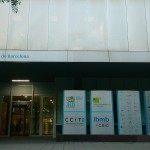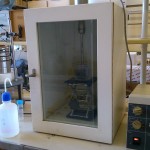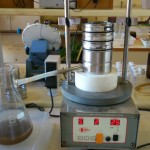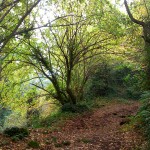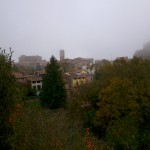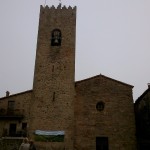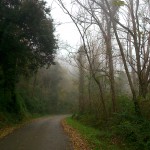The last few days I’ve started doing fractionation of my initial (pre-incubation) soil samples. This consists of separating the soil into different soil fractions: coarse sand, fine sand, coarse silt, and fine silt plus clay. Fine silt plus clay can be further divided into two fractions based on your research interests, but in my case, we are not interested in going that specific so we chose those four fractions. To do this analysis, I have to use the equipment at the Faculty of Biology. We were in luck the day that Joan and I headed over to the lab and found Pere Rovira there. Pere is a researcher at the Forest Sciences Centre of Catalonia in Solsona, a town an hour or so from Barcelona, who frequently collaborates with Joan. However, it just so happened that he was spending the month of November working in the lab at UB; this was good timing for me because Pere is an expert in soil and carbon fractionation. After patiently spending a day showing me all the steps, I was set to begin fractioning. My plans to proceed ended quickly, however, when I realized that the bottom tray that collects the clay and silt fraction appeared to have a hole and soil was collecting inside the tray. So the fractionation was put on hold until the tray could be fixed.
In the meantime, I went to the Parc Cientific at the UB to the elemental analysis lab to weigh my samples for the technician to run them on the CHN analyser for C and N measurements. The place was pretty cool, filled with all sorts of labs, and you need authorization to enter the building (“It’s like the NASA!”, as Joan put it). I definitely wish I could have gotten my samples from Brazil analysed there. I have samples from last year still needing to be analysed!
After waiting for a week for the fractionation bottom tray problem to be solved, Joan looked into where it was made and it turned out they make them right in my neighborhood of Poblenou. So the next day I walked to the factory, bought the piece (pretty pricey considering it’s just a steel tray!) and we were back in business. Hopefully I’ll be done with fractionating my initial samples in the next three weeks.
- Used to break down smaller soil aggregates
- Three sifting pans with different mesh sizes to separate sand, silt and clay
A couple of weekends ago, we went with some other climbing friends to hike in the Fageda d’en Jordá, a famous beech forest near the town of Olot. The forest is unique in Spain for growing on a relatively flat surface formed from lava flow from previous volcanic activity (we actually hiked down into what was the ancient mouth of the volcano). It is part of the Parc Natural de la Zona Volcànica de la Garroxta. This is one of the few places where you can see the leaves changing colors since most of the forests around here are coniferous. The walk was really nice and we stopped in a pretty little town, Santa Pau, to rest. Honestly, though, the changing colors were not as impressive as what I’ve seen in Canada. Here it was a few patches of yellow scattered here and there. BUT, still, it was a really beautiful hike, with both sun and fog.
